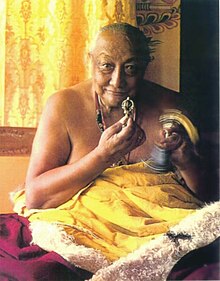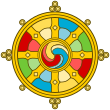Dilgo Khyentse
Dilgo Khyentse | |
|---|---|
 | |
| Title | Rinpoche |
| Personal | |
| Born | 1910 Denkok Valley, Kham Derge, Tibet |
| Died | September 28, 1991 Bhutan |
| Religion | Tibetan Buddhism |
| Spouse | Sangyum Lhamo |
| School | Rimé (Khyentse custodians are technically Sakya) |
| Senior posting | |
| Reincarnation | Jamyang Khyentse Wangpo |
Part of a series on |
| Tibetan Buddhism |
|---|
 |
Schools
|
Key personalities
|
Teachings
|
Practices and attainment
|
Major monasteries
|
Institutional roles
|
Festivals
|
Texts
|
Art
|
History and overview
|
Dilgo Khyentse Rinpoche (Tibetan: .mw-parser-output .uchen{font-family:"Qomolangma-Dunhuang","Qomolangma-Uchen Sarchen","Qomolangma-Uchen Sarchung","Qomolangma-Uchen Suring","Qomolangma-Uchen Sutung","Qomolangma-Title","Qomolangma-Subtitle","Qomolangma-Woodblock","DDC Uchen","DDC Rinzin",Kailash,"BabelStone Tibetan",Jomolhari,"TCRC Youtso Unicode","Tibetan Machine Uni",Wangdi29,"Noto Sans Tibetan","Microsoft Himalaya"}.mw-parser-output .ume{font-family:"Qomolangma-Betsu","Qomolangma-Chuyig","Qomolangma-Drutsa","Qomolangma-Edict","Qomolangma-Tsumachu","Qomolangma-Tsuring","Qomolangma-Tsutong","TibetanSambhotaYigchung","TibetanTsugRing","TibetanYigchung"}དིལ་མགོ་མཁྱེན་བརྩེ་, Wylie: dil mgo mkhyen brtse) (c. 1910 – 28 September 1991) was a Vajrayana master, scholar, poet, teacher, and head of the Nyingma school of Tibetan Buddhism from 1987 to 1991.
As the primary custodian of the teachings of Jamyang Khyentse Wangpo, Dilgo Khyentse was the de facto custodian of the vast majority of Tibetan Buddhist teachings. He taught many eminent teachers, including the Dalai Lama.[1] After the Chinese invasion of Tibet, his personal effort was crucial in the preservation of Tibetan Buddhism.[2]
Contents
1 Biography
1.1 Early life, ancestry
1.2 Buddhist studies
1.3 Move to Tibet, teachings
1.4 Final years
2 Preservation of lineages
3 Dilgo Khyentse Yangsi Rinpoche
4 Film
5 Publications
6 Sources
7 References
8 External links
Biography
Early life, ancestry
He was born in 1910 in the Denhok Valley at Kham Derge, Eastern Tibet, to a family directly descended from the ninth-century King Trisong Detsen. His father was a minister to the King of Derge. When he was seven years old, he was publicly recognized as one of the reincarnations of Jamyang Khyentse Wangpo by Shechen Gyaltsap Rinpoche (1871–1926) at Shechen, one of the six principal monasteries of the Nyingmapa school. During the next few years Dilgo Khyentse received full schooling from various tutors, in addition to training in meditation, and in the study of the dharma in general, and of tantra specifically.
His root guru was Shechen Gyaltsap Rinpoche, and Dzongsar Khyentse Chokyi Lodro (1893–1959) was his other main spiritual master. After he completed what is known as the Preliminary Practices (Ngöndro), Khyentse spent most of the next 13 years in silent retreat in remote hermitages and caves near his birthplace.
Buddhist studies
After completing his retreat at the age of 28, Khyentse spent many years with Dzongsar Khyentse Chokyi Lodro. After receiving from Khyentse Chokyi Lodro the many empowerments of the Rinchen Terdzo (the collection of Revealed Treasures or termas), Dilgo Khyentse requested to spend the rest of his life in solitary meditation. But Khyentse Chokyi Lodro answered, "The time has come for you to teach and transmit to others the countless precious teachings you have received."
Additionally he received teachings at Palpung Monastery from the 11th Tai Situ Rinpoche, and full instruction on the ancient Guhyagarbha Tantra and its various commentaries from Khenpo Tubga at Kyangma Ri-tro. In all he studied with over 50 teachers from the various oral and practice lineages of Tibetan Buddhism.[3]
Later on, the Dalai Lama regarded Dilgo Khyentse as his principal teacher in the Nyingma tradition and of Dzogchen. Khyentse was also one of the main teachers of Chögyam Trungpa, whom he held in high regard.
Move to Tibet, teachings
In the 1950s, as rebellions broke out in Kham in response to the imposition of Chinese Communist rule, Khyentse and his family escaped to central Tibet, leaving behind his library of dharma books and most of his own writings. Then in 1959, after the 14th Dalai Lama left Tibet, Khyentse, his family and a few disciples left Tibet, including his brother, the 9th Sangye Nyenpa Rinpoche and Tenga Rinpoche,[4] and headed for Bhutan. The royal family of Bhutan invited him to stay there and teach.
Later, as he made frequent visits to give teachings to the 14th Dalai Lama at Dharamasala in India, he began giving teachings all over the Himalayas, India, Southeast Asia and the West. He also engaged in scholarship and composed numerous poems, meditation texts and commentaries. He was a terton (a discoverer of spiritual treasures) and was considered to have discovered numerous termas. He was one of the leading masters of the pith-instructions of Dzogchen, the Great Perfection, and one of the principal holders of the Longchen Nyingtik tradition.
In 1980, he founded the Shechen Tennyi Dargyeling Monastery in Nepal, where he transplanted the Shechen tradition to a new home near the great stupa of Boudhanath, just northeast of Kathmandu. There he gave many teachings over the years to hundreds of other lamas, disciples, and students from around the world. Over this same period, and until his paranirvana in 1991, Khyentse was involved in publishing as many Tibetan Buddhist teachings as possible, over 300 volumes altogether.
Final years
He was one of the few Tibetan Lamas accorded the honorific title "His Holiness". Following the death of Dudjom Rinpoche in 1987, he became the head of the Nyingma School, and remained so until his death in Bhutan on 28 September 1991.
Final cremation ceremonies were held for him over a three-day period near Paro in Bhutan, in November 1992 and were attended by over 100 lamas, the Royal Family and ministers of Bhutan, 500 western disciples and 50,000 devotees.
Preservation of lineages

Dilgo Khyentse Rinpoche in Seattle, 1976
Gyatrul (b. 1924),[5] in a purport to Karma Chagmé (Wylie: karma-chags-med, fl. 17th century), conveys Khyentse's 'samaya' (Sanskrit), diligence and humility in receiving 'wang' (Tibetan), lineal transmission and 'rlung' (Wylie) as rendered into English by Wallace (Chagmé et al., 1998: p. 21):
With respect to oral transmission, even if the lineage is impure, it is not a problem. Dilgo Khyentse Rinpoche often sought out and received any oral transmission he thought was on the verge of disappearing. It made no difference who was giving it. He would receive it and, in turn, pass it on to make sure that the lineage remained unbroken.[6]
Dilgo Khyentse Yangsi Rinpoche

Dilgo Khyentse Yangsi Rinpoche at Nyima Dzong
Dilgo Khyentse Yangsi Rinpoche, aka Ugyen Tenzin Jigme Lhundrup (Tib. ཨོ་རྒྱན་བསྟན་འཛིན་འཇིགས་མེད་ལྷུང་གྲུབ་, Wylie o rgyan bstan 'dzin 'jigs med lhun grub), the son of Tsikey Chokling Rinpoche and brother of Phakchok Rinpoche, who currently resides in Bhutan, was appointed as the incarnation of Dilgo Khyentse Rinpoche in December 1995:[7]
Khyentse Yangsi Rinpoche was born in Nepal on June 30, 1993. When Khyentse Rinpoche passed away, his close students requested Trulshik Rinpoche, his most senior and accomplished disciple, to find his incarnation.[7]
In 2015 he visited the newly-opened Buddhist Community Centre UK in Aldershot in the United Kingdom.[8]
Film
The film Spirit of Tibet: Journey to Enlightenment, The Life and World of Dilgo Khyentse Rinpoche was released in 1998. It was made by Matthieu Ricard (French photographer, Buddhist monk, and author) who had traveled with Khyentse for 14 years. It tells Khyentse's story from birth to death, to rebirth, and of his escape following China's invasion of Tibet to his determination to preserve and transmit Buddhist teachings far and wide. The film reveals Tibet's art, ritual philosophy, and sacred dance. Along with rarely photographed areas of Tibet, Bhutan and Nepal, the film features interviews with the Dalai Lama, who speaks about his own spiritual life.
The film Brilliant Moon: Glimpses of Dilgo Khyentse Rinpoche, written and directed by Neten Chokling, and narrated by Richard Gere and Lou Reed, uses animation, previously unseen archival footage and photos along with new interviews of Tibet's teachers to tell Khyentse's life story.
Publications
- Brilliant Moon: The Autobiography of Dilgo Khyentse
- Translated by Ani Jinba Palmo
- Paperback: 400 pages; Publisher: Shambhala
- (January 12, 2010); .mw-parser-output cite.citation{font-style:inherit}.mw-parser-output .citation q{quotes:"""""""'""'"}.mw-parser-output .citation .cs1-lock-free a{background:url("//upload.wikimedia.org/wikipedia/commons/thumb/6/65/Lock-green.svg/9px-Lock-green.svg.png")no-repeat;background-position:right .1em center}.mw-parser-output .citation .cs1-lock-limited a,.mw-parser-output .citation .cs1-lock-registration a{background:url("//upload.wikimedia.org/wikipedia/commons/thumb/d/d6/Lock-gray-alt-2.svg/9px-Lock-gray-alt-2.svg.png")no-repeat;background-position:right .1em center}.mw-parser-output .citation .cs1-lock-subscription a{background:url("//upload.wikimedia.org/wikipedia/commons/thumb/a/aa/Lock-red-alt-2.svg/9px-Lock-red-alt-2.svg.png")no-repeat;background-position:right .1em center}.mw-parser-output .cs1-subscription,.mw-parser-output .cs1-registration{color:#555}.mw-parser-output .cs1-subscription span,.mw-parser-output .cs1-registration span{border-bottom:1px dotted;cursor:help}.mw-parser-output .cs1-ws-icon a{background:url("//upload.wikimedia.org/wikipedia/commons/thumb/4/4c/Wikisource-logo.svg/12px-Wikisource-logo.svg.png")no-repeat;background-position:right .1em center}.mw-parser-output code.cs1-code{color:inherit;background:inherit;border:inherit;padding:inherit}.mw-parser-output .cs1-hidden-error{display:none;font-size:100%}.mw-parser-output .cs1-visible-error{font-size:100%}.mw-parser-output .cs1-maint{display:none;color:#33aa33;margin-left:0.3em}.mw-parser-output .cs1-subscription,.mw-parser-output .cs1-registration,.mw-parser-output .cs1-format{font-size:95%}.mw-parser-output .cs1-kern-left,.mw-parser-output .cs1-kern-wl-left{padding-left:0.2em}.mw-parser-output .cs1-kern-right,.mw-parser-output .cs1-kern-wl-right{padding-right:0.2em}
ISBN 978-1590307632
- Enlightened Courage: An Explanation of Atisha's Seven Point Mind Training
- by Rab-Gsal-Zla-Ba, Dilgo Khyentse Rinpoche
- Paperback: 120 pages; Publisher: Snow Lion Publications
- (December 1, 1993);
ISBN 1-55939-023-9
- Guru Yoga : According to the Preliminary Practice of Longchen Nyingtik
- by Rab-Gsal-Zla-Ba, Matthieu Ricard, Dilgo Khyentse Rinpoche, Rigpa
- Paperback: 101 pages; Publisher: Snow Lion Publications
- (December 1, 1999);
ISBN 1-55939-121-9
- Journey to Enlightenment: The Life and World of Khyentse Rinpoche, Spiritual Teacher from Tibet
- by Matthieu Ricard (Photographer) [Dilgo Khyentse Rinpoche's disciple], Rab-Gsal-Zla-Ba, Padmakara Translation Group (Translator)
- Hardcover: 151 pages; Publisher: Aperture
- 1st ed edition (October 1, 1996);
ISBN 0-89381-679-5
- The Excellent Path to Enlightenment
- by Dilgo Khyentse Rinpoche
- Paperback: 128 pages; Publisher: Snow Lion Publications
- (April 1, 1996);
ISBN 1-55939-064-6
- The Heart Treasure of the Enlightened Ones
- by Dilgo Khyentse Rinpoche, Patrul Rinpoche (Foreword by the Dalai Lama)
- Paperback: 280 pages; Publisher: Shambhala;
ISBN 0-87773-493-3
- The Hundred Verses of Advice : Tibetan Buddhist Teachings on What Matters Most
- by Dilgo Khyentse Rinpoche, Padama Sangye
- Hardcover: 176 pages; Publisher: Shambhala
- (February 15, 2005);
ISBN 1-59030-154-4
- The Lotus-Born: The Life Story of Padmasambhava
- by Erik Pema Kunsang, His Holiness Dilgo Khyentse Rinpoche, Tsele Natsok Rangdrol, Yeshe Tsogyal
- Paperback: 336 pages; Publisher: North Atlantic Books, Rangjung Yeshe
- (October 10, 2004);
ISBN 962-7341-55-X
- The Wish-Fulfilling Jewel
- by Dilgo Khyentse Rinpoche
- Paperback: 120 pages; Publisher: Shambhala;
- Reprint edition (March 16, 1999);
ISBN 1-57062-452-6
- The Collected Works of Dilgo Khyentse Vols. 1-3
- by Dilgo Khyentse Rinpoche
- Hardcover: 1808 pages; Publisher: Shambhala; (January 11, 2011)
- 1st edition;
ISBN 978-1-59030-887-5

Undated late photo

In regalia

Khyentse in 1976

The younger Khyentse
Sources
Khyentse, Dilgo (2008). Brilliant Moon: The Autobiography of Dilgo Khyentse. Ani Jinpa Palmo (trans). Shambhala. ISBN 978-1-59030-284-2.
Nyoshul Khenpo (2006). Marvelous Garland of Rare Gems: Biographies of Masters of Awareness in the Dzogchen Lineage. Richard Barron (trans). Padma Publishing. ISBN 1-881847-41-1.
References
^ "Dilgo Khyentse Rinpoche and "The Heart Treasure of the Enlightened Ones"". www.ramdass.org. Retrieved 27 August 2015.
^ Palmo, Ani Jinba. Brilliant Moon. Shambhala Publications 2008, page 199.
^ Midal (2004) p. 40
^ Tenga Rinpoche, Visions in Exile p. 193-197, in Brilliant Moon: The Autobiography of Dilgo Khyentse
^ Source: "Archived copy". Archived from the original on 2008-12-29. Retrieved 2009-03-25.CS1 maint: Archived copy as title (link) (accessed: Wednesday March 25, 2009)
^ Chagmé, Karma (author, compilor); Gyatrul Rinpoche (commentary) & Wallace, B. Alan (translator) (1998). A Spacious Path to Freedom: Practical Instructions on the Union of Mahamudra and Atiyoga. Ithaca, New York, USA: Snow Lion Publications.
ISBN 978-1-55939-071-2;
ISBN 1-55939-071-9, p.21
^ ab "Dilgo Khyentse Yangsi Rinpoche". Archived from the original on December 18, 2009. Retrieved 2011-05-23.CS1 maint: BOT: original-url status unknown (link)
^ Khyentse Yangsi Rinpoche in France and Great Britain - Shechen Buddhist website
- Midal, Fabrice (2004) Chögyam Trungpa: His Life and Vision
ISBN 1-59030-098-X
External links
| Wikimedia Commons has media related to Dilgo Khyentse. |
| Wikiquote has quotations related to: Dilgo Khyentse |
- Dilgo Khyentse Fellowship - Shechen
Longchen Foundation Founded by Dilgo Khyentse Rinpoche and Chögyam Trungpa Rinpoche
Dilgo Khyentse Rinpoche - at Rigpa Wiki



